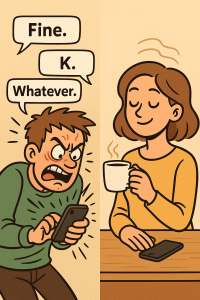According to various relationship counsellors, there are four main types of attachment styles. How to understand our attachment styles and those of our partner may help to better form a meaningful connection so here are their main characteristics.
1. Secure:
- Characteristics: People with a secure attachment style are comfortable with intimacy, trust, and emotional closeness. They are usually confident in relationships and are able to both give and receive love, affection, and support.
- Behavior in Relationships: They are open with their emotions, can communicate effectively, and are comfortable depending on others, as well as allowing others to depend on them.
- Childhood Origins: Secure attachment often forms when caregivers are consistently responsive, nurturing, and available during a child’s early years.
2. Anxious:
- Characteristics: Individuals with an anxious attachment style often crave closeness and approval but may worry about rejection or abandonment. They tend to be emotionally dependent on their partners.
- Behavior in Relationships: They may appear needy, clingy, or overly concerned about their relationship’s stability, often seeking constant reassurance.
- Childhood Origins: This attachment style can develop when caregivers are inconsistent in providing care and affection, leading the child to become anxious about whether their needs will be met.
3. Avoidant:
- Characteristics: People with avoidant attachment are emotionally distant and tend to avoid intimacy and closeness. They often value independence over relationships.
- Behavior in Relationships: They might suppress their emotions, avoid deep emotional connections, and prioritize self-reliance, which can make them seem detached or dismissive in relationships.
- Childhood Origins: Avoidant attachment often stems from caregivers who were emotionally unavailable or unresponsive to a child’s needs, leading the child to learn to rely on themselves and avoid relying on others for emotional support.
4. Fearful Avoidant:
- Characteristics: Also known as disorganized attachment, this style combines both anxiety about intimacy and avoidance of closeness. People with this style desire emotional connections but simultaneously fear getting hurt or rejected.
- Behavior in Relationships: They may exhibit a push-pull dynamic, alternating between seeking closeness and withdrawing. They can struggle with trust, and their relationships may be unpredictable.
- Childhood Origins: Anxious-avoidant attachment is often the result of trauma, neglect, or abusive experiences in childhood, where caregivers were both a source of fear and comfort.
Attachment styles (2), (3) and (4) can also have their origins from a previous romantic relationship; hence it’s always useful to understand your partner’s past, not to criticise or judge, but to understand how they need to be loved and communicated with and this is vital for a long lasting bond.



